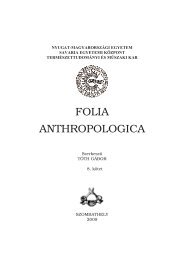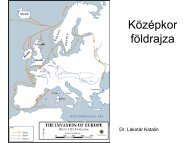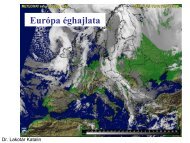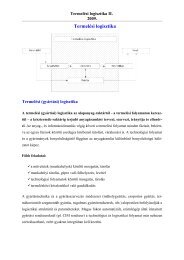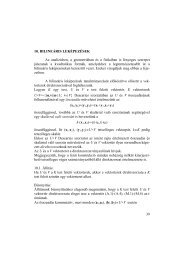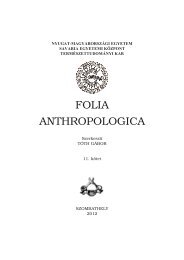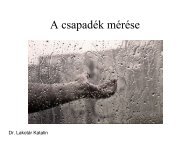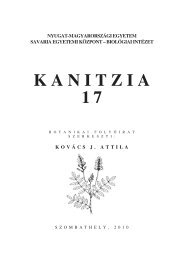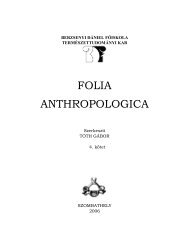Kanitzia 18. - NYME Természettudományi Kar - Nyugat ...
Kanitzia 18. - NYME Természettudományi Kar - Nyugat ...
Kanitzia 18. - NYME Természettudományi Kar - Nyugat ...
You also want an ePaper? Increase the reach of your titles
YUMPU automatically turns print PDFs into web optimized ePapers that Google loves.
liance, keeping various steppic elements in South-Eastern and Central Europe (CHYTRÝ et<br />
al. 2007). They have a large distribution in Transylvania also (CSŰRÖS et al. 1961, SOÓ<br />
1947, RESMERIŢĂ et al. 1968, SANDA et al. 2008, KOVÁCS 2009). Stands of Stipa capillata<br />
with the coenotic participation of Krascheninnikovia ceratoides have been identificated<br />
near the localities Pănet, Poaiana and Groapa, all these situated in the area of Central Transylvania<br />
(Transylvanian Plain).<br />
The coenotic stands occur on south- south-western facing slopes of warm, dry<br />
and eroded sites, sunny flanks and landslide slopes, developed on clay, sand and marly<br />
substrates. The dry grasslands of Stipa capillata (A-D: 25-50%) were used as pastures long<br />
time, but nowdays they remained mostly as abandoned lands. In the species composition<br />
of the stands, whithout the character species (Stipa capillata, Potentilla arenaria) of the<br />
community, there can be recognized the small coenotic group of Krascheninnikovia ceratoides<br />
(K. ceratoides, Agropyron cristatum, Artemisia campestris, Astragalus monspessulanus)<br />
also. In this vegetation unite, the participation and local frequency of the xeric<br />
generalist species of dry grasslands is significant: Linum austriacum, Vinca herbacea, Festuca<br />
rupicola, Campanula sibirica, Jurinea mollis, Astragalus austriacus, Elymus hispidus,<br />
Scabiosa ochroleuca, Stachys recta, Adonis vernalis (Festucetalia valesiacae), Salvia<br />
nemorosa, Poa angustifolia, Medicago falcata, Teucrium chamaedrys, Euphorbia cyparissias,<br />
Anthericum ramosum, Koeleria cristata (Festuco-Brometea) etc. In some sampling<br />
plots important steppic plants have been recognized like Salvia nutans, Stipa lessingiana<br />
(Groapa), Gypsophila collina (Poiana), Asyneuma canescens (Pănet) which indicate the<br />
strong coenotic relations with the steppe-meadows vegetation. Coenotic relationship with<br />
the semi-dry grasslands and fringe communities is demonstrated by the presence of Trifolio-Geranietea<br />
and Brometalia species: Dorycnium herbaceum, Brachypodium pinnatum,<br />
Galium glaucum, Tanacetum corymbosum, Inula ensifolia, Securigera varia etc. The dendrogram<br />
of the cluster analysis of the sampled plots (Fig. 5) and the ordination diagram<br />
(Fig. 6) shows that all relevés separated in the group of Stipetum capillatae having coordinate<br />
position and basic coenological relationships with the sampling plots of Bothriochloetum<br />
ischaemi and, having a distance, being in a marginal position from the relevés<br />
of Agropyro cristati-Krascheninnikovietum ceratoidis. The distance between the relevés<br />
(18–24) and their field fragmentation and separation showed the specific niche and ecological<br />
conditions of the Transylvanian Basin.<br />
Conclusion<br />
Coenological and ecological survey on the steppic and dry grasslands in Transylvania<br />
demonstrated the presence and the distribution of the Eurosiberian (anatolo-iranoturanian-pontic)<br />
floral element, the Krascheninnikovia ceratoides in new sites. The species<br />
with disjunct area and with isolated population-stands in Europe is considered as a relict<br />
of the cold dry climate of the periglaciar landscape. Field investigation on vegetation ecology<br />
and coenological relations of all actually known sites in the Transylvanian Basin (near<br />
Vultureni, Groapa Rădăii, Poiana Frăţii and Pănet) showed that this drought and cold resistant<br />
species is well adapted to abrupt reliefs, open dry sites, steep slopes with southerly-<br />
72




